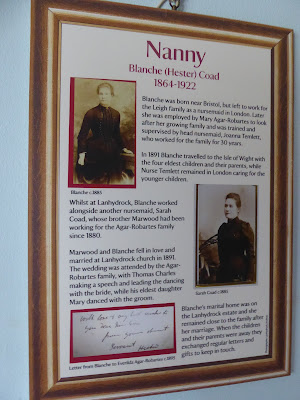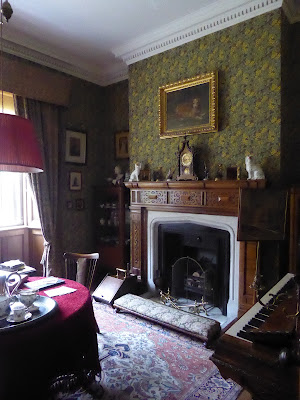
Lanhydrock in Cornwall is a magnificent, late Victorian country house surrounded by 1000 acres
of wooded parkland.
Sheep and cattle are used to keep the grass under control but in the Spring areas are left ungrazed so the wild flowers can bloom and spread their seeds.
After a devastating fire in 1881 the house was refurbished in the high Victorian style.
Lanhydrock was built in 1630-42 for the Robertes family. Originally merchants and bankers they rose to the peerage as Barons pf Truro and then earls of Radnor. A fire in 1881 destroyed most of the house except the 116ft gallery with its barrel vaulted ceiling. The house was rebuilt to include all modern conveniences of the day. 54 rooms are open to visitors. Here are a few of them.
I assume the dairymaids would be responsible for making the butter and cheese. In a room off the kitchen was the dairy with this butter churn.
On the next floor was the office of the estate manager.
At the other end of the house away from the main rooms is the nursery wing with a nursery, a playroom a schoolroom and the Nanny's bedroom. Between 1879 and 1895 the Robartes had ten children, one of whom died at a very young age.
The Nanny's room was next to the nursery.
There was also a schoolroom but the boys would have gone off to boarding school from about 6 or 7 years of age.
The servants' rooms are unusually spacious. This was one of the footman's bedroom.
The luggage room
 |
| The master's bathroom |
 |
This is the long gallery which survived the fire. The room contains the National Trust's most important library consisting of the collection of the 1st Earl of Radnor (1606-85).

William Morris printed wallpaper adorned some of the rooms.



This was their eldest son's bedroom. Thomas Agar-Robertes (1880-1915) heir to the estate died during the First World War. On the bed is a suitcase containing his personal items.
Out of their surviving nine children only one daughter married and had just the one son. Three of their sons died during WW1. In the end the house and estate was given to the National Trust in 1953.



































While I can see it is roped, you can get close enough to take good photos. The garden looks nice.
ReplyDeleteQuite a beautiful place!
ReplyDeleteThank you for the extensive tour. I enjoyed it very much. A very different way of life back then. :-)
ReplyDeleteI did briefly think of Downton Abbey. IO had to smile at the ringing of bells for service. The poor housemaid would be put on alert each time as she waited for additional rings to get her off the hook.
ReplyDeleteEven with nannies, nursery boarding schools servants etc I wouldn't want 10 children ! The mother saw them probably once per year at Christmas. What a big gap between the social standings.
ReplyDeleteThey even had a dairy maid! Thanks for the tour.
ReplyDeleteOh I would love to tour this place. I love that so many of the belongings are in place.
ReplyDeleteHooray, they let you take photos! What a grand gatehouse at the entrance.
ReplyDeleteThat nursery reminds me a bit of the children's bedroom in Nanny McPhee with all those beds in a row.
ReplyDeleteWow they lived well in those days. Its good that it went to the National Trust to keep history alive.
ReplyDeleteI enjoyed the tour through your photographs, thank you.
ReplyDeleteIt is good that it went to the National Trust and they keep its history alive for others to see.
All the best Jan